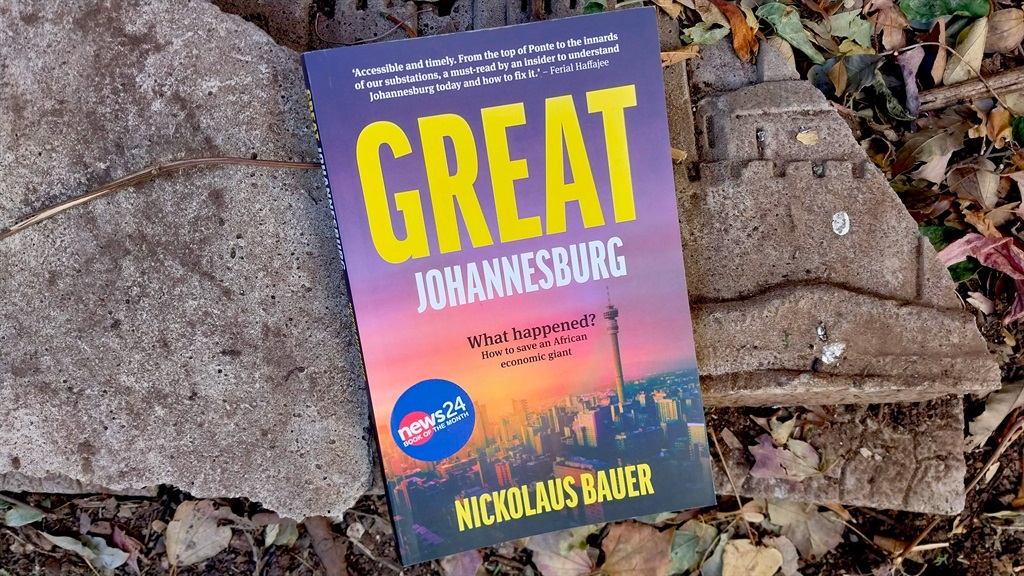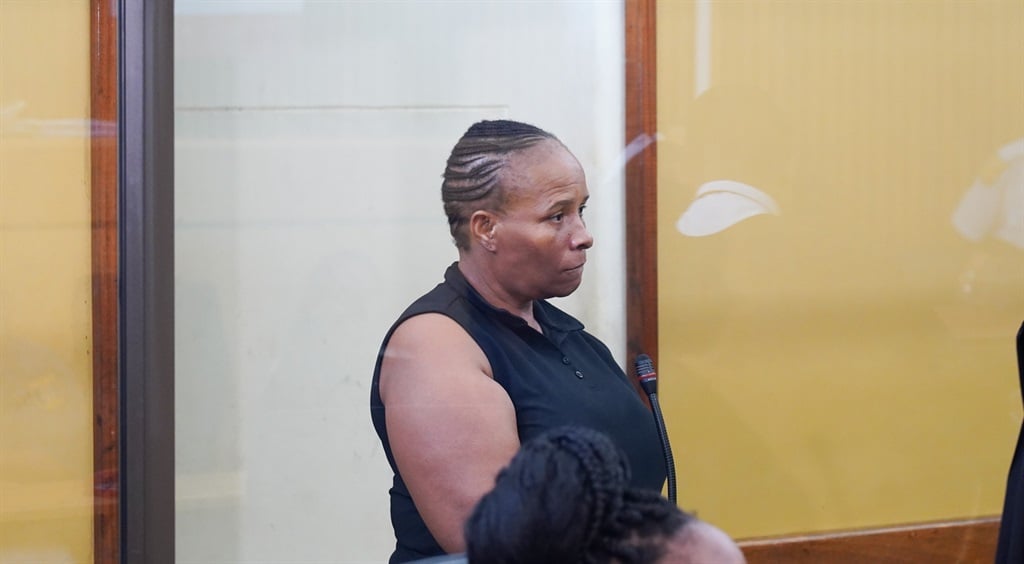
News24’s Book of the Month for July, Nickolaus Bauer’s Great Johannesburg: What Happened? How to Save an African Economic Giant is a comprehensive portrait of the city.
The book covers many aspects of Jozi life, from zama zamas to water cuts, blackouts, exploding streets and political instability. Is the City of Gold in a death spiral? Bauer examines the current crisis by starting with Johannesburg’s origins as a cauldron of cultures and a hustler’s haven. He looks at how a city of migrants turned into a xenophobic hotspot, how the politics of gold, the shadow of apartheid and the evolution of the tsotsi – crime and criminality – affect life in Johannesburg today, and what can be done about these.
With chapters on redlining, the walkability of the city, corporate corruption, mayoral musical chairs and the proliferation of illegal backyard buildings, Great Johannesburg provides a comprehensive analysis of the current malaise, as it outlines possible solutions.
Bauer has covered Johannesburg as a political journalist since 2008 and lived in the inner city since 2010, eight years of which were in Hillbrow and five years in the Ponte Towers. He worked within the Johannesburg city administration as a Deputy Director for the Environment and Infrastructure Services Department in 2022.
In this extract, Bauer looks at redlining and why it’s disastrous for the inner city.
BOOK: Great Johannesburg: What Happened? How to Save an African Economic Giant by Nickolaus Bauer (Tafelberg)
“Look how fucked this place is now!” “This used to be the best of Johannesburg – the best of South Africa. And now it’s all gone to shit! Any why? Because they moved in”
I wasn’t that surprised by the outburst. These were fairly standard sentiments among large parts of the white community in the 1980s and 1990s in South Africa as the country transitioned towards democracy. But I did think it was pretty ballsy for someone who used to call Hillbrow their stomping ground shouting this in the middle of the street, surrounded by black people. On a Dlala Nje tour highlighting the regeneration and hope of contemporary Hillbrow and the Johannesburg inner-city. Ballsy maybe but ignorant mostly.
The worn out narrative of Hillbrow’s transformation from Apartheid era Bohemian haven to democratic multiracial slum being down to the rapid influx of black South Africans is pervasive. But with the blame now being apportioned to the Zimbabweans, Nigerians and Malawians that call the infamous inner city suburb home. New black people arriving in Hillbrow have often been portrayed as having different standards, ultimately wanting to live in a hovel and responsible for the overall social and physical decline of the area.
But labelling Hillbrow as a no-go area today because of the influx of people of a darker hue or different African nationality is not only racist but simply false.
Hillbrow was one of the first neighbourhoods in South Africa to become racially diverse in spite of the Group Areas Act of 1950. From its proclamation in 1895 the neighbourhood was always a hub for new arrivals to the city and its uniquely ethno-diverse flavour accelerated in the 1960s with the rapid import of skilled European labourers due to the Apartheid government shutting black people out of the booming economy. Germans, Brits, Dutch, Italians, French, Portuguese and the like settled in the 36 city block, 1KM2 suburb as it quickly became an oasis of modern Western urbanity in Africa. But from the late 1970s the whites-only urban areas Apartheid policy began crumbling as Hillbrow became a grey area. Grey area being the lame and unimaginative term coined by Apartheid authorities to define places where legally forbidden racial mixing was taking place. Initially on dance floors in nightclubs and later in high-rise flat bedrooms. The common excuse for a mixed race household being to dismiss the non-white residents of a home as the domestic help if authorities ever questioned an interracial living arrangement. This explanation being futile in the presence of mixed children though.
In 1985 more than 90% of the population in Hillbrow was white. By the early 1990s more than 80% of the suburb’s population was black and was quickly followed by the literal physical decline of the neighbourhood. The condemnation of a correlation was swift from not only the all white government but also the press, former inner-city aficionados and fleeing European migrants. But while that may have complimented racial sentiments and white fear it said nothing of the broader environment. While the area’s increased racial mixing did indeed coincide with a drop in living standards, the causal effect of this being a misconception. Critically, it completely ignores the role of disastrous redlining that struck the suburb down.
There was indeed a red menace that crept through Johannesburg and South Africa from the 1980s onwards. But it was not in the communism Apartheid apparatchiks frothed at the mouth about. Redlining is the discriminatory practice of denying services to specific communities by banks, financial institutions and/or local authorities due to its perceived economic undesirability. The term originated in the mid-20th century USA after red lines were literally drawn on maps by bank managers and local councillors to separate areas where financial institutions and local authorities would avoid making investments or providing services.
Redlining by banks meant no loans, mortgages and/or insurance being afforded to an area deemed unworthy. While basic services and infrastructure maintenance would be withdrawn by local authorities. Disproportionately affecting minority African American communities as early as the 1930s across America from Philadelphia to San Diego.
It is an absolute disaster in socioeconomic terms, effectively switching off the financial taps and leading to an area’s rapid degradation. Redlining may have been banned in the USA in 1968 but its effects remain across the world from Amsterdam to Calcutta. In effect surviving through disproportionately higher interest rates being enforced in undesirable areas, effectively making loans out of reach. Hillbrow is just one Johannesburg suburb famous for redlining with the effects – depressed investment, urban decay and higher interest rates among others – on full display to this day. The swift demographic change in Hillbrow as Apartheid began to crumble severely spooked not only the government but big business too. Leading to a chicken versus egg debate: What came first the falling standards of the area or the turning off of the economic taps? Ponte posh becomes Ponte slum
No other building encapsulates what happens when an area falls to redlining than the infamous Ponte. The very thought of the building still remains cringe-worthy to many Joburgers who continue to see it as a den of iniquity. Historically, Ponte Towers was the place to be and when it opened its doors in 1975, it was the crème de la crème of city living. One of the very first live, work and play building concepts in Johannesburg the 54 story and 173m high concrete monolith with a hollow core attracted the city’s more affluent residents.
But, by the mid-1980s, Hillbrow’s melting pot of cultures became the site of rapid urban degeneration fuelled by redlining. Accordingly, Ponte’s glory days ended almost as quickly as they came with tales of drug dealers, prostitutes and criminals running free within its circular walls. Residents of that era claim the 11th and 12th floors were completely stripped bare and, along with the downstairs parking lot, were nothing more than spots to score anything ranging from an acid trip to a blow job. And why did the building do a complete 180 degree turn in just 15 to 20 years?
The exact same formula had been applied to it as in other parts of Hillbrow: initial racial mixing led to tacit tolerance, an influx of new non-white middle class residents as well as poor people on the pavements outside. While spiking interest rates worsened the financial situation as property prices plummeted and financial institutions and authorities got spooked. The red ink began to spill and before long the building was in the same boat as many others in the area. By 2001 Ponte was Africa’s first vertical urban slum with a building initially constructed for 1000 residents, now home to up to 8000 with no running water or electricity and trash piled to the 14th floor in its hollowed out core.
Luckily, the contemporary story of Ponte is vastly different. Home to over 2 000 residents, there is now an orderly waiting list to become a resident in Ponte as one of the most sought after addresses for the middle class of Johannesburg central suburbs. However, the same cannot be said of Hillbrow and other areas that also fell victim to redlining.
If you don’t think the process exists anymore, then try and get a mortgage to buy a property in Berea, Troyeville, Bertrams, Sophiatown, Yeoville and other city suburbs that have fallen into social ruin amid the competing realities of the biggest city in the world’s most unequal society. Successfully combating redlining once it has arrived in an area is a herculean task.
Redlining has maybe lost its potency with it being loosely thrown around, but it continues to cast a dark shadow on efforts to desegregate and restructure areas in democratic South Africa. The first step in tackling this scourge would be stringent legislation explicitly prohibiting redlining practices and ensuring equal access to housing loans. Ideally at a national level but to be implemented by the Johannesburg council if necessary. Moreover, community action in maintaining an area is crucial in forcing financial institutions to actively contribute to the revitalization of historically redlined neighbourhoods in Johannesburg.
What incentive would a bank have in investing if it’s apparent the residents of an area simply do not care about its upkeep? The alternative to addressing these historical injustices is to simply perpetuate redlining practices for generations to come. Lending credence to the nauseating ignorance that latter day Apartheid racial mixing and uncontrolled contemporary African migration has led to the decay of places like Hillbrow.




Recent Comments